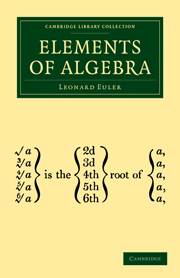Book contents
- Frontmatter
- ADVERTISEMENT
- MEMOIR OF THE LIFE AND CHARACTER OF EULER, BY THE LATE FRANCIS HORNER, ESQ., M. P.
- ADVERTISEMENT BY THE EDITORS OF THE ORIGINAL, IN GERMAN
- ADVERTISEMENT BY M. BERNOULLI, THE FRENCH TRANSLATOR
- Contents
- PART I Containing the Analysis of Determinate Quantities
- SECTION I Of the Different Methods of calculating Simple Quantities
- SECTION II Of the different Methods of calculating Compound Quantities
- SECTION III Of Ratios and Proportions
- SECTION IV Of Algebraic Equations, and of the Resolution of those Equations
- Chap. I Of the Solution of Problems in General
- Chap. II Of the Resolution of Simple Equations, or Equations of the First Degree
- Chap. III Of the Solution of Questions relating to the preceding Chapter
- Chap. IV Of the Resolution of two or more Equations of the First Degree
- Chap. V Of the Resolution of Pure Quadratic Equations
- Chap. VI Of the Resolution of Mixed Equations of the Second Degree
- Chap. VII Of the Extraction of the Roots of Polygonal Numbers
- Chap. VIII Of the Extraction of Square Roots of Binomials
- Chap. IX Of the Nature of Equations of the Second Degree
- Chap. X Of Pure Equations of the Third Degree
- Chap. XI Of the Resolution of Complete Equations of the Third Degree
- Chap. XII Of the Rule of Cardan, or that of Scipio Ferreo
- Chap. XIII Of the Resolution of Equations of the Fourth Degree
- Chap. XIV Of the Rule of Bombelli, for reducing the Resolution of Equations of the Fourth Degree to that of Equations of the Third Degree
- Chap. XV Of a new Method of resolving Equations of the Fourth Degree
- Chap. XVI Of the Resolution of Equations by Approximation
- PART II Containing the Analysis of Indeterminate Quantities
- ADDITIONS BY M. DE LA GRANGE
Chap. XIV - Of the Rule of Bombelli, for reducing the Resolution of Equations of the Fourth Degree to that of Equations of the Third Degree
Published online by Cambridge University Press: 05 July 2011
- Frontmatter
- ADVERTISEMENT
- MEMOIR OF THE LIFE AND CHARACTER OF EULER, BY THE LATE FRANCIS HORNER, ESQ., M. P.
- ADVERTISEMENT BY THE EDITORS OF THE ORIGINAL, IN GERMAN
- ADVERTISEMENT BY M. BERNOULLI, THE FRENCH TRANSLATOR
- Contents
- PART I Containing the Analysis of Determinate Quantities
- SECTION I Of the Different Methods of calculating Simple Quantities
- SECTION II Of the different Methods of calculating Compound Quantities
- SECTION III Of Ratios and Proportions
- SECTION IV Of Algebraic Equations, and of the Resolution of those Equations
- Chap. I Of the Solution of Problems in General
- Chap. II Of the Resolution of Simple Equations, or Equations of the First Degree
- Chap. III Of the Solution of Questions relating to the preceding Chapter
- Chap. IV Of the Resolution of two or more Equations of the First Degree
- Chap. V Of the Resolution of Pure Quadratic Equations
- Chap. VI Of the Resolution of Mixed Equations of the Second Degree
- Chap. VII Of the Extraction of the Roots of Polygonal Numbers
- Chap. VIII Of the Extraction of Square Roots of Binomials
- Chap. IX Of the Nature of Equations of the Second Degree
- Chap. X Of Pure Equations of the Third Degree
- Chap. XI Of the Resolution of Complete Equations of the Third Degree
- Chap. XII Of the Rule of Cardan, or that of Scipio Ferreo
- Chap. XIII Of the Resolution of Equations of the Fourth Degree
- Chap. XIV Of the Rule of Bombelli, for reducing the Resolution of Equations of the Fourth Degree to that of Equations of the Third Degree
- Chap. XV Of a new Method of resolving Equations of the Fourth Degree
- Chap. XVI Of the Resolution of Equations by Approximation
- PART II Containing the Analysis of Indeterminate Quantities
- ADDITIONS BY M. DE LA GRANGE
Summary
765. We have already shewn how equations of the third degree are resolved by the rule of Cardan; so that the principal object, with regard to equations of the fourth degree, is to reduce them to equations of the third degree. For it is impossible to resolve, generally, equations of the fourth degree, without the aid of those of the third; since, when we have determined one of the roots, the others always depend on an equation of the third degree. And hence we may conclude, that the resolution of equations of higher dimensions presupposes the resolution of all equations of lower degrees.
766. It is now some centuries since Bombelli, an Italian, gave a rule for this purpose, which we shall explain in this chapter.
Let there be given the general equation of the fourth degree, x4 + ax3 + bx2 + cx + d = 0, in which the letters a, b, c, d, represent any possible numbers; and let us suppose that this equation is the same as (x2 + ½ax + p)2 − (qx + r)2 = 0, in which it is required to determine the letters p, q, and r, in order that we may obtain the equation proposed. By squaring, and ordering this new equation, we shall have
Now, the first two terms are already the same here as in the given equation; the third term requires us to make, which gives; the fourth term shews that we must make ap − 2qr = c, or 2qr = ap − c; and, lastly, we have for the last term p2 − r2 = d, or r2 = p2 − d.
- Type
- Chapter
- Information
- Elements of Algebra , pp. 278 - 282Publisher: Cambridge University PressPrint publication year: 2009First published in: 1822

